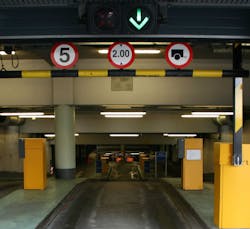Report: Adoption of ANPR technology could lead to barrier-free parking
With more cities around the world turning to automated number plate recognition (ANPR) cameras and software as part of their efforts to alleviate issues related to ticket payments and security in parking garages, a new report from IHS says that ANPR technology could eventually replace barriers and loop detectors as the sole solution used to automate parking structures.
According to Justin Siller, research manager for security and building technologies at IHS, the idea of eliminating the aforementioned security measures in favor of ANPR technology is slowly starting to gain traction in the market. Here is the rest of Siller’s research note on the trend towards using ANPR technology to create free-flowing parking structures:
Free-flow parking can use ANPR technology to scan plates of cars as they enter and exit a facility, offering real benefits to parking lot operators and customers. One benefit of barrier-free parking is it can eliminate bottlenecks at entrances and exits.
These holdups are a real frustration for customers, where lines can back-up and create significant wait times to enter and exit. For entry, cars would now no longer have to stop to collect a ticket upon arrival and could drive straight into a facility to park. When exiting, payments would already have been made, allowing cars to leave immediately without having to stop to make payment. This would get rid of the need to have barriers, booth attendants or payment stations at the entrance and exit points.
Another benefit is it can be extremely expensive to build entry/exit lanes. With faster throughputs, fewer lanes would be required because cars would be able to easily move in and out of the structure. The additional space could be used for more parking spots, creating the possibility of lower costs and higher returns for parking lot owners.
Finally, barrier-free parking is convenient for customers. Parking structures need a way to distinguish themselves from one another to win new customers and to retain existing ones. Reducing or eliminating wait times makes for better customer service and can keep users happier. Operators can also create convenience for everyday clients with parking payment subscriptions that keep a credit card on file to be charged each time the license plate is scanned. These customers would then never have to worry about payment when parking.
Today, the main barriers to widespread acceptance free-flow parking are ANPR equipment prices and the possibility of lost payments. Parking facilities that use ANPR cameras today typically install low-cost solutions because parking barriers are present. Cars are required to come to a complete stop in the entrance and exit lanes, which makes a low-end product sufficient enough to scan, read and produce an image of the license plate. If the barriers are removed, cars would be in motion when driving through the lanes, which requires a better and more expensive product.
Avoiding payments is also an issue where users could just leave without paying to park. The question is then, how would operators collect the fee if this were to occur? The simple answer is the fee would likely go uncollected and would become lost revenue. However, parking lot operators can store the license plate of the offender so this never happens with the same car twice. This then makes lost payments an issue only with one-time users.
The key for ANPR equipment vendors is to educate end-users about the total cost of traditional parking systems. ANPR technologies eliminate the need to buy traditional equipment making the free-flow parking option more affordable. Combine this with the benefits to customers, and the market could soon see change. While the trend to barrier-free parking is unlikely to occur in the short-term, in its latest report "World Market for ANPR and Detection Sensors," IHS has stated it expects free-flow parking to gain momentum during the next five years. This will occur as end-users recognize the benefits and manufacturers push the solution as an alternative to the traditional systems used today.
